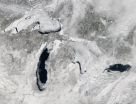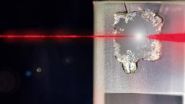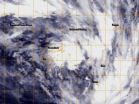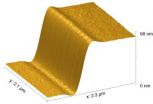(Press-News.org) At night, as cold settles in, lake ice creaks and groans. It's been excessively cold, and I camped exposed on the snow-swept surface. Other than the lack of vegetation and the sounds at night, you'd never know you were on a lake. It feels like an empty plain. In some places, you see pressure ridges where ice has pushed into itself, sticking up like clear blue stegosaurus plates. -- Craig Childs
Author Craig Childs is not describing an Arctic lake. He's describing the bitterly cold and frozen scene on Lake Superior, during his February 2014 trek on the ice near the coast of Ashland, Wisconsin.
Zoom out to view the scene from a satellite perspective and it's apparent that Lake Superior is not the only lake to feel the freeze. The true-color image above, from the Moderate Resolution Imaging Spectroradiometer (MODIS) on NASA's Aqua satellite, shows the mostly frozen state of the Great Lakes on Feb. 19. On that date, ice spanned 80.3 percent of the lakes, according to NOAA's Great Lakes Environmental Research Laboratory in Ann Arbor, Mich.
The ice reached an even greater extent on Feb. 13, when it covered about 88 percent of the Great Lakes – coverage not achieved since 1994, when ice spanned over 90 percent. In addition to this year, ice has covered more than 80 percent of the lakes in only five other years since 1973. The average annual maximum ice extent in that time period is just over 50 percent. The smallest maximum ice cover occurred in 2002, when only 9.5 percent of the lakes froze over.
Scientists say it's understandable that the Great Lakes have had so much ice this year considering the cold temperatures in the region that persisted through the winter. Cold air temperatures remove heat from the water until it reaches the freezing point, at which point ice begins to form on the surface, explained Nathan Kurtz, cryospheric scientist NASA's Goddard Space Flight Center in Greenbelt, Md.
"Persistently low temperatures across the Great Lakes region are responsible for the increased areal coverage of the ice," Kurtz said. "Low temperatures are also the dominant mechanism for thickening the ice, while secondary factors like clouds, snow, and wind also play a role."
The freeze this year has local implications, including possible changes to snowfall amounts in the Great Lakes area, explained Walt Meier, also a cryospheric scientist at NASA Goddard. When the lakes are primarily open water, cold air picks up moisture from the relatively warm and moist lake water, often resulting in lake effect snow on the lee side of the lakes, on the eastern and southern shores. When the lakes freeze, the lake effect generally shuts down. "Although this year, they're still picking up a fair amount of snow," Meier said.
Lake levels could also see an impact by summer, as winter ice cover generally reduces the amount of water available to evaporate during winter months. If that turns out to be the case, it would be "good news for local water supplies, as well as for shipping and recreational use," Meier said.
It remains to be seen when the Great Lakes will once again freeze to the extent reached in 2014, or at least enough to allow adventurers to reach the ice caves at Lake Superior's Apostle Islands National Lakeshore by foot.
A 2012 study in the Journal of Climate by scientists at NOAA's Great Lakes lab, which included data from MODIS, found that winter season ice cover on Lake Superior has decreased 79 percent from 1973 to 2010. The study also showed that ice cover on the lakes is highly variable and difficult to predict.
The harsh season this year "is a reminder that winters are variable and that weather can always throw an outlier our way," said Gavin Schmidt, a climatologist and climate modeler at NASA's Goddard Institute for Space Studies in New York.
INFORMATION:
NASA satellite sees great freeze over Great Lakes
2014-02-28
ELSE PRESS RELEASES FROM THIS DATE:
Ultra-fast laser spectroscopy lights way to understanding new materials
2014-02-28
Scientists at the U.S. Department of Energy's Ames Laboratory are revealing the mysteries of new materials using ultra-fast laser spectroscopy, similar to high-speed photography where many quick images reveal subtle movements and changes inside the materials. Seeing these dynamics is one emerging strategy to better understanding how new materials work, so that we can use them to enable new energy technologies.
Physicist Jigang Wang and his colleagues recently used ultra-fast laser spectroscopy to examine and explain the mysterious electronic properties of iron-based superconductors. ...
Detection of water vapor in the atmosphere of a hot jupiter
2014-02-28
Although liquid water covers a majority of Earth's surface, scientists are still searching for planets outside of our solar system that contain water. Researchers at Caltech and several other institutions have used a new technique to analyze the gaseous atmospheres of such extrasolar planets and have made the first detection of water in the atmosphere of the Jupiter-mass planet orbiting the nearby star tau Boötis. With further development and more sensitive instruments, this technique could help researchers learn about how many planets with water—like Earth—exist within ...
Smoke in the water: Understanding the effects of smoke compounds on seed germination
2014-02-28
Although seemingly destructive, wildfires help to maintain biodiversity and are an important element of many ecosystems throughout the world. Not only do fires discourage non-native and invasive species from becoming established, but the quick release of nutrients, heat, and compounds found in ash and smoke play an important role in the life cycle of the native flora. For plants that are adapted to ecosystems where fire is a regular occurrence—such as savannas, grasslands, and coniferous forests—exposure to fire may initiate seed germination or enhance plant growth.
Recent ...
The nature of color: New formula to calculate hue improves accuracy of color analysis
2014-02-28
A stroll through the produce aisle in your local grocery store exhibits a plethora of vivid colors. From opposing hues, like red apples next to green celery, to subtler variations, such as light to dark purple grapes, every color seems to hold its own unique attraction. Is there a way to precisely measure these hundreds of colors? This is a crucial question for scientists studying the biological importance of color in nature, but measuring color is much more challenging than measuring other characteristics, like size or weight. In recent work, University of Colorado researcher ...
Tropical Cyclone 16P forms near Fiji
2014-02-28
Tropical Cyclone 16P formed near Fiji after lingering in the region for several days as a tropical low pressure area. NOAA's GOES-West satellite captured an infrared image of the storm on February 28.
NOAA's GOES-West satellite image showed the center of Tropical Cyclone 16P to the northeast of Fiji and over Vanua Levu. Broken bands of thunderstorms wrapping from the north to the east and southeast reached Wallis and Fortuna, Samoa, Niue and Tonga.
At 0900 UTC/4 a.m. EST, Tropical Cyclone 16P was centered about 170 nautical miles/`95.6 miles/314.8 km northeast of Suva, ...
To teach scientific reproducibility, start young
2014-02-28
DURHAM, N.C. -- The ability to duplicate an experiment and its results is a central tenet of the scientific method, but recent research has shown an alarming number of peer-reviewed papers are irreproducible.
A team of math and statistics professors has proposed a way to address one root of that problem by teaching reproducibility to aspiring scientists, using software that makes the concept feel logical rather than cumbersome.
Researchers from Smith College, Duke University and Amherst College looked at how introductory statistics students responded to a curriculum ...
Asthma drug aids simultaneous desensitization to several food allergies, study finds
2014-02-28
STANFORD, Calif. — An asthma drug accelerates the process of desensitizing patients with food allergies to several foods at the same time, a new study by researchers at the Stanford University School of Medicine and Lucile Packard Children's Hospital Stanford shows.
The findings come on the heels of a recent study by the same team showing that people with multiple food allergies can be desensitized to several foods at once. The two studies, both phase-1 safety trials, provide the first scientific evidence that a promising new method for treating people for multiple food ...
Beneficial anti-inflammatory effects observed when plant extracts fed to sick pigs
2014-02-28
URBANA, Ill. – Porcine reproductive and respiratory syndrome (PRRS) is the most expensive and invasive disease for pig producers on a global scale. Though it is not occurring on every farm, it is the biggest disease problem in the pig industry, said a University of Illinois animal sciences researcher.
E. coli has also been a problem historically and continues to be on an industry-wide basis, said James Pettigrew. "Either disease can sweep through a farm so their alleviation would substantially reduce production costs. Even though many management practices have been used ...
Waterloo physicists solve 20-year-old debate surrounding glassy surfaces
2014-02-28
University of Waterloo physicists have succeeded in measuring how the surfaces of glassy materials flow like a liquid, even when they should be solid.
A series of simple and elegant experiments were the solution to a problem that has been plaguing condensed matter physicists for the past 20 years.
Understanding the mobility of glassy surfaces has implications for the design and manufacture of thin-film coatings and also sets practical limits on how small we can make nanoscale devices and circuitry.
The work is the culmination of a project carried out by a research ...
Burmese pythons pose little risk to people in Everglades
2014-02-28
EVERGLADES NATIONAL PARK, Fla. -- The estimated tens of thousands of Burmese pythons now populating the Everglades present a low risk to people in the park, according to a new assessment by U.S. Geological Survey and National Park Service scientists.
The human risk assessment looked at five incidents that involved humans and Burmese pythons over a 10-year period in Everglades National Park. All five incidents involved pythons striking at biologists who were conducting research in flooded wetlands.
"Visitor and staff safety is always our highest priority at Everglades ...



